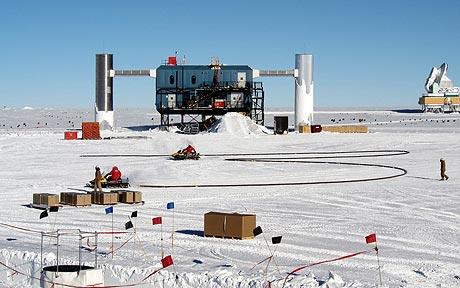
For the past ten years scientists have been planning and building an ambitious experiment to explain the mystery of what produces the cosmic rays and elusive particles known as neutrinos, which constantly pepper our planet.
They have buried thousands of sensors more than a mile below the surface of Antarctica's ice cap to record fleeting flashes of blue light that are given off when these high energy particles and rays collide with atoms in the ice.
By recording the pattern of light from the collisions, the sensors can plot the trajectory of the particles and rays, allowing scientists to pinpoint where in the galaxy they came from.
Analysis has already begun of results from the $271 million (£169 million) IceCube Neutrino Observatory - described by scientists as a "telescope" - although the last of its sensors is not due to be installed until December.
It has revealed a hot spot of galactic cosmic rays coming from an area close to the constellation of Vela, which appears in the shape of a ship's sail in the skies of the southern hemisphere. It is known to be an area of space that emits large amounts of radiation throughout the galaxy.
Scientists now hope that when the observatory is finally completed, they will be able to accurately identify what is responsible for the stream of high energy cosmic rays and neutrinos that pass through the galaxy.
Recent research suggests that galactic cosmic rays may change the Earth's climate, affecting weather and cloud cover.
Cosmic rays - high energy particles thrown out into space at close to the speed of light - may trigger thunderstorms, by creating the electrical charge in the air that causes lightning.
For years cosmic rays and neutrinos were thought to emanate from the remnants of exploding stars known as supernovas, or from supermassive black holes. But in recent years astronomers have begun to question this theory. They hope the IceCube experiment will provide an answer.
Professor Subir Sarkar, a particle astrophysicist at Oxford University who leads the British involvement in the IceCube experiment, said: "Cosmic rays were discovered 100 years ago, but we still have no idea where they come from.
"At first glance, IceCube seems like a crazy experiment. How can you study the sky when you bury your detectors a mile beneath the ice? But it gives us a new way of tracing their paths back to their source.
"The real excitement is that neutrinos and cosmic rays will reveal an entirely new way of looking at the universe and allow us to see into places where we haven't been able to before. Currently we have no way of peering into black holes through the dust and gas that surrounds them, so if high energy neutrinos are being emitted from their fringes, then we can 'see' into places we have been able to before."
When high energy particles in the cosmic rays smash into other matter, radiation and neutrinos are created.
After light, neutrinos, are the most abundant particles in the universe. But it is extremely difficult for scientists to detect them because they have no charge and almost no mass, meaning they can pass through rock, metal and even human bodies without effect.
Very rarely a neutrino will strike an atom, producing another particle called a muon and a shockwave, which results in a burst of blue light - which the sensors will record.
Antarctica is the best place to do this because of the ultra-clear ice, almost completely clear of air bubbles and other distortions, found 1.2 miles beneath the surface of the ice cap, a result of high pressure exerted from tons of ice above.
Eventually scientists will bury more than 5,000 optical sensors deep in the ice, covering an area of around one cubic kilometre (0.2 cubic miles).
The collisions are so rare that only a few will be spotted every year, but the scientists say they have already detected collisions since the first sensors were buried in 2006.
Researchers involved in the project, which is being led by the University of Wisconsin Madison, are now considering new ways of extending the area of the experiment.
At a meeting this month in Brussels, scientists raised the prospect of searching for collisions over hundreds of miles of ice with a battery of radio wave detectors buried in the ice. They would monitor radio waves created by the collisions.
Highly sensitive microphones could also be used to listen out for the distinctive sounds produced in the ice by the collisions.



Reader Comments
to our Newsletter